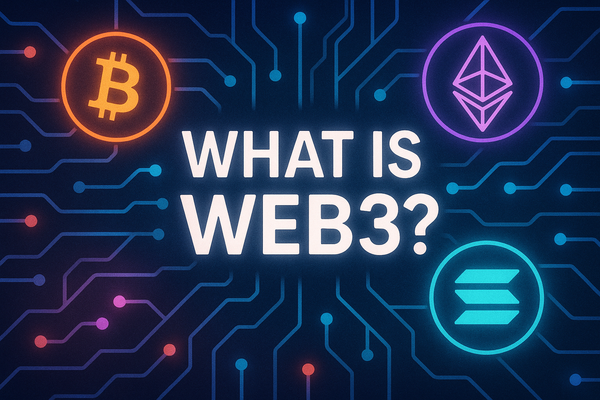What Is a Bitcoin Node? A Complete Guide for Beginners
Bitcoin nodes are the unsung heroes of the network. This guide breaks down what they are, how they work, and why running one empowers you.

Bitcoin is often described as a decentralized digital currency, but what ensures this decentralization actually works? The answer lies in a vast global network of computers known as nodes. These nodes form the backbone of the Bitcoin protocol, enabling the system to function without a central authority.
While Bitcoin mining often steals the spotlight, nodes quietly play a more foundational role: they enforce the rules. Without nodes, there would be no consensus, no ledger integrity, and ultimately, no Bitcoin as we know it. Understanding what a Bitcoin node is—and why it matters—is essential for anyone serious about grasping how Bitcoin maintains its trustless, decentralized structure.
This article will break down the concept of Bitcoin nodes from the ground up, including the types of nodes, how they operate, and why some users choose to run one themselves. Whether you're a curious investor, an aspiring developer, or a privacy-conscious user, understanding nodes can help you appreciate the real architecture behind Bitcoin’s resilience.
What Is a Bitcoin Node?
A Bitcoin node is a computer that participates in the Bitcoin network by running the Bitcoin Core software or another compatible implementation. Its job is to validate transactions and blocks, enforce consensus rules, and communicate with other nodes to keep the network synchronized.
At its core, a node maintains a complete (or partial) copy of the blockchain—the public ledger that records every transaction in Bitcoin’s history. This allows the node to independently verify new transactions and blocks without relying on trust. Unlike wallets or exchanges that may depend on third-party infrastructure, nodes operate autonomously, serving as both guardians and gatekeepers of the protocol.
There’s a common misconception that Bitcoin mining and running a node are the same thing. In reality, they’re different roles. Miners propose new blocks and collect rewards, but it’s nodes that determine whether those blocks follow the rules. If a miner submits an invalid block, nodes will reject it. In this way, nodes collectively maintain Bitcoin’s integrity.
By connecting to peers and relaying valid data, each node contributes to a decentralized mesh network where no single entity has control. This permissionless architecture is what makes Bitcoin censorship-resistant and globally accessible.
Types of Bitcoin Nodes
Bitcoin nodes come in several forms, each with different capabilities and responsibilities. Understanding these distinctions is key to appreciating how the network stays decentralized and secure.
1. Full Nodes
Full nodes download and verify the entire Bitcoin blockchain, currently hundreds of gigabytes in size. They independently validate every transaction and block, ensuring compliance with the consensus rules. Most full nodes also relay information to other nodes, contributing to the robustness of the network. Bitcoin Core is the most common full node software.
2. Pruned Nodes
A pruned node is a type of full node that discards older block data after verifying it. While it still validates all transactions and blocks, it only stores a user-specified amount of recent blockchain history. This saves disk space while preserving full verification functionality, making it suitable for users with limited storage.
3. Light Nodes (SPV Clients)
Lightweight or Simplified Payment Verification (SPV) nodes don’t download the full blockchain. Instead, they rely on full nodes for block headers and use cryptographic proofs to verify transactions. SPV clients, like mobile wallets, are faster and more resource-efficient, but they sacrifice some security and independence by trusting third parties.
4. Archival Nodes
These are full nodes that retain the entire blockchain history without pruning. They’re valuable for explorers, researchers, and services that need access to historical data. While not required for consensus, archival nodes play a supporting role in transparency and data accessibility.
Each type serves different user needs, but together they form a layered, resilient network that supports Bitcoin’s global reach.
How Bitcoin Nodes Work
Bitcoin nodes are the rule enforcers of the network. While miners propose new blocks, it’s the nodes that determine whether those blocks—and the transactions within them—are valid. This decentralized validation process is what maintains Bitcoin’s integrity and security.
When a node receives a new transaction, it checks the transaction against Bitcoin’s consensus rules. These include ensuring that the sender has enough funds (by checking the UTXO set), verifying digital signatures, and confirming the format is correct. If the transaction is valid, the node adds it to its mempool—a holding area for unconfirmed transactions—and relays it to other nodes.
Similarly, when a miner finds a new block and broadcasts it, each node independently verifies it. This includes checking the block’s proof-of-work, ensuring it links correctly to the previous block, and confirming that all contained transactions are valid. If the block passes all checks, the node accepts it and adds it to its version of the blockchain. If not, the block is rejected.
Nodes also help resolve chain conflicts by following the longest valid chain with the most proof-of-work. This ensures all honest nodes eventually converge on a single version of history, even if temporary forks occur.
Behind the scenes, nodes maintain peer-to-peer connections with other nodes, constantly exchanging data to keep the network synchronized. This gossip protocol allows information to propagate quickly and efficiently, with no central server or coordinator.
In essence, nodes uphold the rules, reject invalid data, and ensure the ledger remains accurate—all without requiring trust in any single participant.
Why Run a Bitcoin Node?
Running a Bitcoin node offers significant benefits—both to individual users and the network as a whole. At its core, a node provides independence. By validating transactions and blocks yourself, you no longer need to trust third-party services. You verify your own transactions and confirm they follow Bitcoin’s rules.
Privacy is another major advantage. When you use lightweight wallets or centralized exchanges, you often leak data about your balances and transactions. A personal node allows your wallet to interact with the network directly, without exposing your financial activity to intermediaries.
For technically minded users, running a node is a way to contribute to Bitcoin’s decentralization. Every active node helps strengthen the network against censorship and attacks. The more nodes exist worldwide, the harder it becomes for any single government or organization to manipulate or restrict Bitcoin usage.
Some people run nodes to support specific projects—like Lightning Network routing, block explorers, or privacy tools like Wasabi Wallet. Others do it simply to deepen their understanding of how Bitcoin works.
While you won’t earn rewards like miners do, running a node gives you sovereignty over your Bitcoin experience. It turns you from a passive participant into an active one, reinforcing the core principle of Bitcoin: don’t trust—verify.
Setting Up a Bitcoin Node
Setting up a Bitcoin node is more accessible than many people think. With the right hardware and some basic technical knowledge, you can be up and running in a matter of hours.
The most common way to run a node is to download and install Bitcoin Core, the reference implementation of the Bitcoin protocol. It’s available for Windows, macOS, and Linux. Once installed, the software will begin downloading the entire blockchain, which currently exceeds 500 GB. This process can take several days depending on your internet speed and hardware.
Minimum requirements typically include:
- A desktop or dedicated mini-PC (like a Raspberry Pi 4 or Intel NUC)
- At least 1 TB of SSD storage (HDDs are discouraged due to slower sync)
- 8 GB of RAM (4 GB may suffice for lightweight use)
- A reliable broadband connection with no strict data caps
Some users opt for plug-and-play node devices like Umbrel, myNode, or Nodl, which bundle Bitcoin Core with user-friendly interfaces and optional services like Lightning Network or Tor integration.
After setup, you can optionally configure your router to allow inbound connections on port 8333, helping other nodes connect to your node and improving network health.
Running a node is relatively low-maintenance. Once synced, it runs quietly in the background, continuously verifying and relaying data—your personal gateway to the Bitcoin network.
Challenges and Considerations
While running a Bitcoin node has clear benefits, there are some practical challenges to consider—especially for non-technical users.
Storage and bandwidth are the most obvious hurdles. The Bitcoin blockchain is large and constantly growing. A full node needs at least 500 GB of storage and can consume up to 200 GB of data per month, depending on usage and network activity. Users with limited internet plans or older computers may struggle to keep up.
Initial sync time can also be significant. Downloading and verifying the entire blockchain may take days or even a week, especially on slower connections or mechanical hard drives. Using an SSD and enabling pruning can help reduce this burden.
There’s also a learning curve. While plug-and-play solutions exist, managing a node—especially if you want to run additional services like a Lightning node—requires some technical familiarity with command-line tools, port forwarding, and system security.
Lastly, running a node offers no financial reward, which may discourage casual users. It’s a voluntary act of self-sovereignty and support for the network, not a way to earn passive income.
That said, for those willing to take the leap, the value of operating your own node often outweighs the hassle.
The Role of Nodes in Bitcoin’s Decentralization
Decentralization is Bitcoin’s most defining characteristic—and nodes are the reason it works. Unlike traditional financial systems that rely on trusted intermediaries, Bitcoin operates through a network of independent nodes that collectively enforce the rules without needing permission or oversight.
Every full node independently verifies transactions and blocks based on the consensus protocol. This means that no central authority can alter Bitcoin’s monetary policy, censor transactions, or forge history. If a powerful entity attempts to rewrite the blockchain with invalid rules, honest nodes will reject the changes.
Nodes also resist centralization in other parts of the ecosystem. For example, if major mining pools collude to push harmful updates, nodes can simply refuse to accept their blocks. This check-and-balance dynamic ensures that miners, developers, and businesses all remain accountable to the consensus enforced by node operators.
Importantly, anyone with the necessary hardware and internet connection can run a node—no licenses, no gatekeepers. This open participation model empowers users across the world to help secure the network and preserve Bitcoin’s foundational principle: trust no one, verify everything.
Nodes aren’t just pieces of software—they’re instruments of decentralization, ensuring that Bitcoin remains borderless, censorship-resistant, and resilient.
What Is a Bitcoin Node? FAQ
A Bitcoin node is a computer that connects to the Bitcoin network to validate and relay transactions and blocks based on consensus rules.
No, but running your own node improves privacy and removes reliance on third-party services for transaction verification.
You need a computer with at least 1 TB of SSD storage, 8 GB of RAM, and a stable internet connection without strict data caps.
No, nodes do not earn rewards. They’re run voluntarily to increase personal security and support the decentralized network.
Estimates vary, but there are typically 15,000–50,000 reachable full nodes online at any given time around the world.





